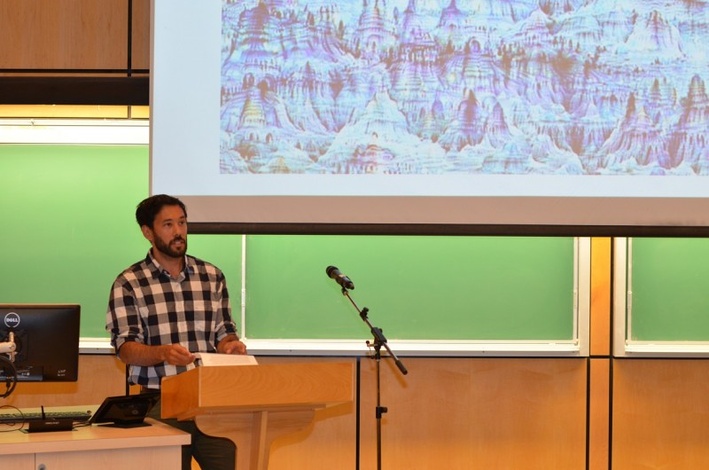Ryan Ikeda at the Digital Humanities Summer Institute
This spring, we were pleased to offer several grants to help support our students in sharing their research at the premiere conferences in their field. Below, Ryan Ikeda reflects on his experience at the Digital Humanities Summer Institute (DHSI) this June in Vancouver, BC, Canada.

Ikeda presenting his paper at DHSI 2017.
Hi BCNM Community –
Thank you for supporting me this summer as I presented a paper at the annual Digital Humanities Summer Institute in Victoria, BC, Canada, entitled “The Inescapable Digital: Rethinking the Position of an Avant-Garde”. My paper centers on the work of Mike Tyka, a sculptor and software engineer, who was the highest-grossing artist at The Gray Area’s first Neural Network Art Show.
What interests me most Tyka is that he considers his photographs the result of a collaborative effort owing in equal part to the synthetic intelligence of DeepDream (a neural network) and to his own creative powers. My paper considers the stakes of such a premise, that is – of an art irreducible to human imagination, or art as a techno-human practice.
On one hand, many theorists in the field of digital poetics and/or new media (Hayles, Morris) have considered the implications of digital technology for contemporary art in discursive terms, arguing that the use of pre-digital metaphors applied to digital culture is anachronistic, out-of- place and out-of- time; argument tantamount to software updates. Like an update, this popular argument assumes that if the old (i.e., print culture) doesn’t react quickly enough by changing / adapting to digital culture, it (print culture) risks obsolescence. Obsolescence of course is an economic term (i.e., planned obsolescence) and entails the time signature of mass production; their distinction, perhaps unknowingly, subordinates art to economic time. However, we often think how the field of aesthetics entails a different temporal signature, one that seeks to disrupt economic time by evoking a sense of the out-of- place and experiences out-of- time.
The avant-garde embraces such a position: its name designates a prepositional relationship to the institution of art as well as a culture / society (as advanced, vanguard) that is at once spatial and temporal. The problem with such a claim has to do with the material conditions underlying digital culture. As McLuhan points out, the light bulb contains no message because it is pure information, it moves at the speed of light and forms the basis of digital technology as such. I consider how the immediacy of digital culture might foreclose a possibility of such an advanced distinction claimed by avant-gardes, instead rendering avant-gardes as belated, reticulated. In order for an avant-garde to bifurcate from obsolescence, it must first recognize its imbrication with technology and problematize its position; disavowing its advanced position may provide a helpful start, though a more thorough response may be to rethink the process of individuation, how an avant-garde becomes advanced. The consequence of such elisions is, unknowingly, to risk redoubling the effects of economic time through art practice.
My paper proposes, then, that the emergence of techno-human collaborations, such as in the case of Mike Tyka, allows critics an occasion to rethink the relation of art to technology as one of co-extension – that is, irreducible to pure technodeterminism or pure subjectivity; and centers art critique around mechanisms of individuation. And yet, such co-extension hinges upon a recognition that the dislocated moments desired by avant gardes can no longer be fabricated or designated through language, but emerge through – what digital theorist Bernard Stiegler calls – disorientation, where the speed of technology augments human capacity for critical reflection.
